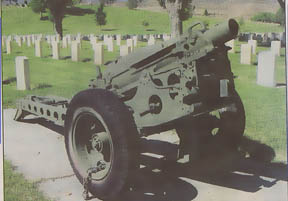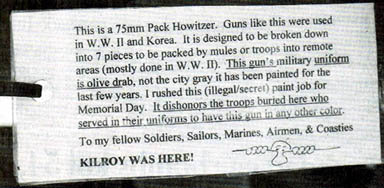|
5/31/2006 The Daily Sentinel, Grand Junction, Colorado. Reprinted with Permission.
"This is a 75mm Pack Howitzer Guns like this were used in WWII and Korea. It is designed to be broken down into 7 pieces to be packed by mules or troops into remote areas (mostly done in WII). This gun's military uniform is olive drab, not the city gray it has been painted for the last few years. I rushed this (illegal/secret) paint job for Memorial Day. It dishonors the troops buried here who served in their uniforms to have this gun in any other color. "To my fellow Soldiers, Sailors, Marines, Airmen and Coasties, "KILROY WAS HERE!"
On Tuesday, the sign seemed to bring Bouchard back in time. "We never did find out who Kilroy was, but he was all over," Bouchard said, chuckling. :He went to war. He was in Europe." Bouchard said he served as a machine gunner in World War II in Normandy, Belgium, and Germany. After enough combat to earn him a Purple Heart, a Bronze Star and other accolades, Bouchard was wounded in a German forest in 1944 and shipped home. Tuesday, Bouchard and his wife, Mary Ellen Green Bouchard, visited the grave of Green Bouchard's first husband, Shelby Green, also an Army veteran from WWII. At the cemetery, they saw the howitzer and Bouchard told a few war stories. "The green is camouflage color," Bouchard said. "We wore combat green. A lot of the vehicles were painted real dark green. From the air it's a lot harder to see."The Army then used plain, dark green, not the medley of varied shades of green used today. In the war Bouchard was a platoon sergeant, a machine gunner. Just like Kilroy Marija B. Vader can be reached via e-mail at mvader@gjds.com 5/26/2007 The Daily Sentinel, Grand Junction, Colorado. Reprinted with Permission. Kilroy slips back in, leaves note in vet's cemetery By GARY HARMON (The Daily Sentinel) Saturday, May 26, 2007 Kilroy slipped back into Grand Junction before Memorial Day to leave a military missive on the howitzer stationed at the veterans section of the Orchard Mesa Cemetery. Kilroy — a reference to ubiquitous graffiti left by and for American soldiers in World War II and Korea — last year painted the howitzer olive drab and chastised the city of Grand Junction for having painted it an embarrassing gray. "It dishonors the troops buried here who served in their uniforms to have this gun in any other color" than olive drab, Kilroy wrote. Left on the howitzer, still garbed in olive drab, again this year was another note. Like its predecessor, the current note reminds the city of the gun's proper color."I hope the city will keep it so painted," the note says ."To my fellow Soldiers, Sailors, Marines, Airmen and Coasties and to our great troops now protecting our country from the terrorist threat — God bless you and Kilroy Was Here. (2007)"
They added to it a bulbous-nosed, bug-eyed face seemingly peering over a wall, back at the viewer. Several legends developed to explain the "Kilroy was here" phenomenon, with the Web site www.KilroyWasHere.org documenting them all. Kilroy's note goes on to make clear, again, that the field piece in question is a 75mm pack howitzer. Such guns were designed to be broken down into seven pieces to be packed by mules or troops into remote areas. Most of them were used during World War II. A similar piece is displayed in front of Fitzsimons Army Medical Center in Aurora. Gary Harmon can be reached, via e-mail at gharmon@gids.com
Send Corrections, additions, and input to:
|

